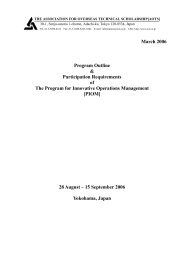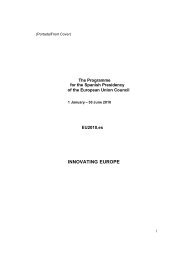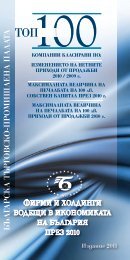Analysis of the Operation and Financial Condition of the Enterprise
Analysis of the Operation and Financial Condition of the Enterprise
Analysis of the Operation and Financial Condition of the Enterprise
You also want an ePaper? Increase the reach of your titles
YUMPU automatically turns print PDFs into web optimized ePapers that Google loves.
<strong>Analysis</strong> <strong>of</strong> <strong>the</strong> <strong>Operation</strong> <strong>and</strong> <strong>Financial</strong> <strong>Condition</strong> <strong>of</strong> <strong>the</strong> <strong>Enterprise</strong>(any increase in <strong>the</strong> capital shows <strong>the</strong> improvement <strong>of</strong> <strong>the</strong> company financial status, or juston <strong>the</strong> contrary – worsening <strong>of</strong> <strong>the</strong> situation). This ratio also describes <strong>the</strong> share <strong>of</strong> currentliabilities that can be repaid not only in cash, but also from expected earnings from anyworks performed, goods dispatched <strong>and</strong> services provided.The reference level <strong>of</strong> <strong>the</strong> ratio is 1, because <strong>the</strong>n an enterprise is in a realposition <strong>of</strong> meeting its current liabilities, it can fully settle its debts with <strong>the</strong> creditorswithout stopping its operations. Overly high quick ratio is not a sign <strong>of</strong> good businessperformance ei<strong>the</strong>r as this would mean that <strong>the</strong>re is too much cash accumulated in till <strong>and</strong>on <strong>the</strong> bank accounts. Too low level <strong>of</strong> <strong>the</strong> ratio could be related to <strong>the</strong> fact that <strong>the</strong>re isei<strong>the</strong>r too much stock in <strong>the</strong> enterprise or that <strong>the</strong>re are difficulties in selling this stock.In <strong>the</strong> majority <strong>of</strong> cases <strong>the</strong> most secure assessment <strong>of</strong> liquidity is by <strong>the</strong> amount<strong>of</strong> cash assets at <strong>the</strong> disposal <strong>of</strong> an enterprise. This value is called <strong>the</strong> absolute liquidityratio <strong>and</strong> estimated as <strong>the</strong> relationship between cash <strong>and</strong> current liabilities:Absolute liquidityratio=Cash in till <strong>and</strong> at bankCurrent liabilities(4.4.)If <strong>the</strong>re are any short-term securities at <strong>the</strong> disposal <strong>of</strong> an enterprise, <strong>the</strong>se shouldalso be added to <strong>the</strong> amount <strong>of</strong> cash assets, because <strong>the</strong>y are ei<strong>the</strong>r already expressed interms <strong>of</strong> cash or are easily convertible into cash. In this case <strong>the</strong> absolute liquidity ratio iscalculated by <strong>the</strong> following equation:Absolute Cash + Short-term securitiesliquidity ratio=(4.5.)Current liabilitiesThe higher <strong>the</strong> amount <strong>of</strong> current assets is <strong>the</strong> larger <strong>the</strong> probability or repayment<strong>of</strong> <strong>the</strong> short-term debts from <strong>the</strong> existing assets. It is clear though that <strong>the</strong>ir amount willdepend on <strong>the</strong> area <strong>of</strong> operations <strong>of</strong> an enterprise. It is generally accepted that, if <strong>the</strong>relation between current assets <strong>and</strong> current liabilities is lower than 2:1, an enterprise is notin a position <strong>of</strong> meeting its liabilities in due time <strong>and</strong> amount. An excess <strong>of</strong> current assetsover current liabilities several times indicates a considerable amount <strong>of</strong> spare resourcesei<strong>the</strong>r created from its own assets or by insufficiently using its short-term credits (bankloans <strong>and</strong> trade credits). Form <strong>the</strong> point <strong>of</strong> view <strong>of</strong> efficiency <strong>of</strong> performance inaccumulation <strong>of</strong> stock <strong>the</strong> allocation <strong>of</strong> assts for financing <strong>of</strong> debtors is considered to be anunpr<strong>of</strong>essional use <strong>of</strong> assets.By analysing liquidity <strong>of</strong> an enterprise large attention needs to be devoted toidentification <strong>of</strong> Net current assets or <strong>the</strong> Current capital (Working capital).Net current assets = Current assets – Current liabilities (4.6)Net current assets are required for <strong>the</strong> maintenance <strong>of</strong> financial stability <strong>of</strong> anenterprise, because <strong>the</strong> excess <strong>of</strong> current assets over current liabilities evidences that anenterprise is not only in a position <strong>of</strong> meeting its short-term debts, but it also has <strong>the</strong>financial resources available for expansion <strong>of</strong> business in <strong>the</strong> future.71
















